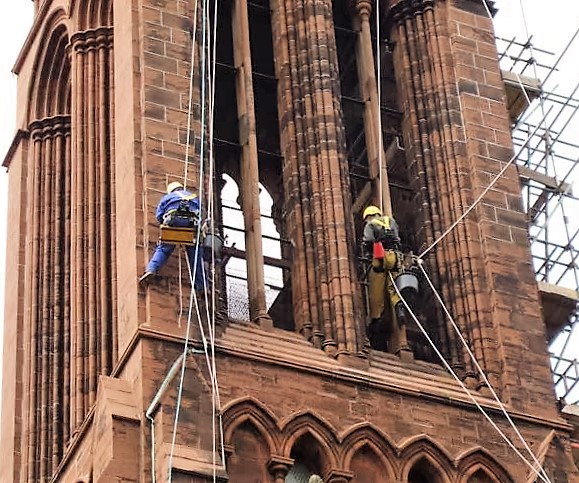In the 19th Century there were around 850 active sandstone quarries in Britain. Across Glasgow, the vast majority of old and historic buildings of the city are all made of red or blonde sandstone.
Whether a tourist hot spot like Kelvingrove Museum or local tenement blocks that are so popular across Glasgow, they are all made of sandstone.

Blonde / Yellow Sandstone
In the 18th and 19th Century, Blonde Sandstone was quarried in and around Glasgow. Quarries were not run to the same large scale that you may associate with in modern times so there were in fact quarries around Kelvingrove and Partick in the West End of Glasgow for example. The majority of blond sandstone used for historic buildings in Glasgow came from local Bishopbriggs and Giffnock quarries pre 1890.
The blonde sandstone used in Glasgow is from the Carboniferous period when Scotland was located close the the equator.
Red Sandstone
Once the railway network in and around Glasgow had been properly established post 1890, it became a lot easier and financially viable to bring in sandstone from outside of the city. The red sandstone quarried from Dumfries and Ayrshire quarries is created from sandstone formed from the Permian period over 270 million years ago. An iron rich coating over the sand grains, similar to what occurs in the Sahara dessert creates the red colouring.

So why do we use the two different colours of sandstone in historic buildings in Glasgow?
While the different sandstone types used in Glasgow buildings does give it a special character, the answer to why some buildings are made from red sandstone and others are made from blonde sandstone is really a combination of factors.
The demand for blonde sandstone not just for construction and building material in Glasgow but across Scotland, meant that many of the smaller quarries in the city became depleted and were swallowed up by general city expansion. This meant that, along with the arrival of a functioning rail network, red sandstone was able to be brought in from quarries in Ayrshire and Dumfriesshire to help meet demand. These larger quarries could supply lots of their red sandstone to meet construction needs and it was found that the red sandstone was actually a more durable stone because it was relatively free of so many of the impurities that can be found in blonde sandstone including mud, clay and carbonaceous material.
Are the quarries in Glasgow and Dumfries still active?
No is the simple answer. None of the original quarries used to help build Glasgow into the largest city in Scotland are still operational. Any blonde sandstone that is currently used for building maintenance and repairs now comes from North England and has to be specially colour matched for consistency to the existing sandstone used in existing buildings.
Maintaining these historic buildings and their stonework
Because of the number of quarries used and the type of sandstone sourced from so many different locations in Scotland, it does mean that the weathering and decay of historic buildings in Glasgow can vary not just because of the age of the building but because of the stone and where it was quarried. So you may see a pristine blonde sandstone home in Pollokshields and a similar style of building in Kelvinside, yet the West End sandstone building is in a more urgent need of repair simply because of which quary the blonde sandstone was sourced from. The exact same scenario can be seen for so many red sandstone buildings across the city. Building Restoration and Maintenance for stonework repairs should only ever be handled by trained and experienced stonemasons who understand the history and complexity of sandstone repairs.
We are Balmore Specialist Contracts and for over 35 years, we have been repairing sandstone buildings across Glasgow and the surrounding towns and villages. Our experience and working knowledge of the differing types of sandstone makes us a leader in our field. It is why we have been chosen to work on so many significant and recognisable historic building restoration projects and Grade A Listed Buildings in our time.

Find out more
If you live in a sandstone property in Glasgow and would like to find out more about how to properly maintain the stonework and help preserve it for the future, please contact us today by calling 0141 944 6100 or emailing sales@balmore-ltd.co.uk








